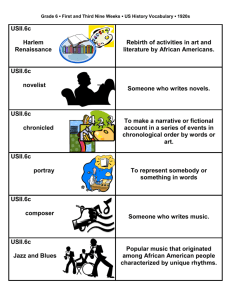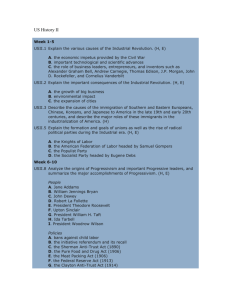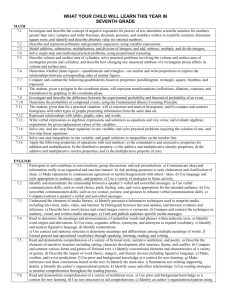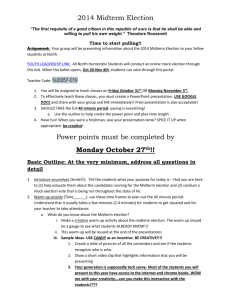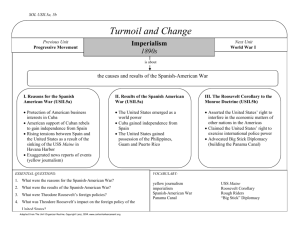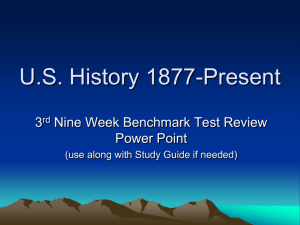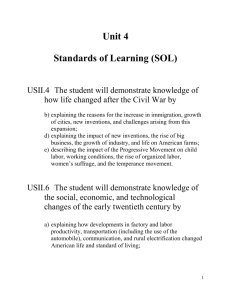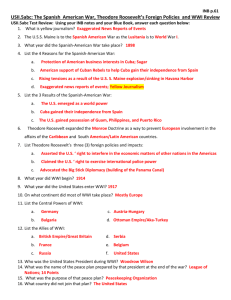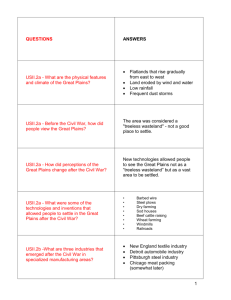HISTORY AND SOCIAL SCIENCE Standards and Benchmarks
advertisement
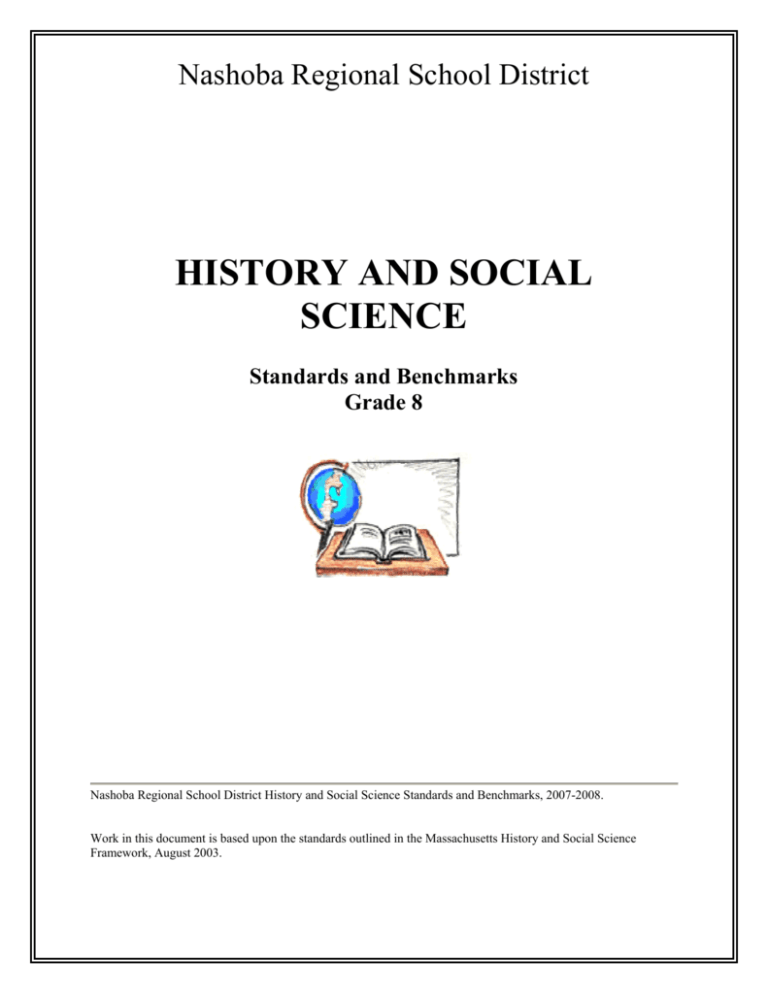
Nashoba Regional School District HISTORY AND SOCIAL SCIENCE Standards and Benchmarks Grade 8 Nashoba Regional School District History and Social Science Standards and Benchmarks, 2007-2008. Work in this document is based upon the standards outlined in the Massachusetts History and Social Science Framework, August 2003. History and Social Studies by Grade Level Grade 8 Massachusetts Curriculum Frameworks (August 2003) Grade Eight Focus: American Government and Modern American History 1898 - Present Concepts and Skills to be addressed: Government Overview: Students will learn about key ideas of the U.S. Constitution and its amendments. Students also study the basic framework of American democracy and the basic concepts of American government such as popular sovereignty, federalism, separation of powers, and individual rights. The role of our government in world affairs will also be explored. Big Idea: People form governments to establish order, provide security, and accomplish common goals. (C, G) Essential Questions: What are the rights and responsibilities of citizenship? What is the function of government and how is it organized? By the end of EIGHTH grade, students should be able to answer the Essential Questions above and apply knowledge and concepts relating to American Government to be able to: • Review the origins of the Constitution (USG 1.9) A. Investigate the influence of the Founding documents on the writing of the Articles of Confederation and the Constitution. (US I.6, US I.7, US I.8, USG1.9, USG 2.5) B. Analyze the role and principles of democracy. (USG1.3, 1.4, 1.5, 1.6, 1.7 & 1.8) C. Understand the purpose and functions of the Bill of Rights. (USI.9) D. Review the importance of the Great Compromise. (US I.7) • Analyze the structure of the Constitution: A. Federalism, Separation of Powers, Checks & Balances. (USI.15, USG 3.3) • Make connections between the amendments and current events. (USG 3.12) • Identify the structure, role and purpose of each of the three branches of government. (US G 3.3, 3.6, USG 4.3) A. Analyze the role of the courts and the criminal justice system. (USG 3.4 and USG5.1) • Describe the varying roles and responsibilities of federal, state and local government. (USI.15) • Compare and contrast democracy, monarchy, oligarchy, autocracy, communism, and fascism. (USI.12) • Identify the concepts of civil rights and individual rights. (USI.15, USG 3.11) 1 2007-2008 Nashoba Regional School District Grade 8 H/SS Standards and Benchmarks Aligned • Identify the duties and responsibilities of citizens. (USI.19, USG 1.1, USG 1.2) • Explain the growth and development of political parties. (USI.20) • Understand the process of how a bill becomes a law. (USG 3.9) Concepts and Skills to be addressed: U.S. History Overview: Students will study America’s economic and social changes of the late 19th through the 20th centuries and its growing involvement in world affairs. They will also explore the fight for civil rights and women’s rights, racial issues and discrimination, changes in immigration and naturalization laws, and the influence of big business on the economy. Finally, students will learn about the changing role of the U.S. during the 20th century through depression, war, cold war and global change. Big Ideas: Social, cultural and political change took place in America from the late 19th through the 20th centuries. During the decades from the 1900s to the 1990s, there was a connection between social, cultural and political events. American “pop culture”- music, media, literature, and science and technology- reflected a mirror of society. Essential Questions: How has America’s role in the world changed over time? How do individuals impact history? By the end of Eighth grade, students should be able to answer the Essential Questions above and apply knowledge and concepts relating to Modern American Topics, 1898 - present, to be able to: UNITED STATES EMERGES AS A WORLD POWER • Explain American interests in Cuba 1898. (USII.6) • Analyze the significance of American acquisition of Guam, Philippines and Puerto Rico (Spanish American War) 1898. (USII.6) • Understand the reasons for American interests in Central American – (Panama Canal, Venezuela Boundary dispute). (USII.6) WOMEN’S RIGHTS • Examine the effect of the Women’s rights movement in the 19th and 20th century through the following events: (USI.33, USII.8) A. The Suffrage amendment B. The Equal Rights amendment 2 2007-2008 Nashoba Regional School District Grade 8 H/SS Standards and Benchmarks Aligned PROGRESSIVE ERA • Analyze the origins of Progressivism and important Progressive leaders, and major accomplishments of the Progressive Era. (US II.8) A. People 1. Teddy Roosevelt 2. Upton Sinclair 3. Ida Tarbell B. Famous Muckrakers C. Policies 1. Ban on Child Labor 2. Initiative referendum and recall 3. Sherman Anti-Trust Act, 1890 4. Pure Food and Drug Act, 1906 5. Meat Packing Act, 1906 6. Federal Reserve Act, 1913 7. Clayton Anti-Trust Act, 1914 8. Nineteenth Amendment, 1920 9. Presidents Roosevelt, Taft and Wilson 10. U.S. Policies regarding child labor, trusts, meat packing and women’s suffrage 11. African American civil rights • Analyze the causes of World War I and America’s entrance in the war. (USII.6) • Explain the course and significance of Wilson’s wartime diplomacy, including his Fourteen Points, the League of Nations and the failure of the Versailles Treaty. (USII.7) • Explain the strength of American isolationism after World War I and analyze the impact on U.S. foreign policy. (USII.14) THE ROARING TWENTIES • Investigate and analyze the following key events: (USII.10) A. Technological advances of Henry Ford and the assembly line. B. Stock market growth and effect on spending, wealth, and emerging middle class. C. Sacco & Vanzetti Trial and execution. D. Scopes Trials E. Prohibition F. Harlem Renaissance G. Teapot Dome Scandal H. Stock market crash I. Red Scare 3 2007-2008 Nashoba Regional School District Grade 8 H/SS Standards and Benchmarks Aligned THE GREAT DEPRESSION • Investigate and analyze the following key events: (USII.10, USII.11, USII.12, USII.13) A. Hoover-villes B. Bonus Army March C. Great Depression D. Election of Franklin Delano Roosevelt E. New Deal agencies and their impact on relief, reform and recovery. F. Unconstitutionality of the National Recovery Act. G. Repeal of prohibition H. Japanese and German aggression in Asia and Europe. I. American Isolationism. J. Dust bowl WORLD WAR II • Analyze German aggression in Europe and Japanese aggression in Asia and the start of World War II. (USII.15) • Locate the allied powers and axis powers on a world map. (USII.15) • Summarize the major battles and events of the war. (USII.15, 16) A. Pearl Harbor B. Midway C. D-Day D. Okinawa E. Battle of the Bulge F. Iwo Jima G. Bataan H. Dropping of atom bombs on Hiroshima and Nagasaki • Analyze American life on the Home front during the war. (USII.17) • Analyze Japanese-American internment. (USII.17) COLD WAR AMERICA • Define and identify examples of the Cold War. (USII.18, 19, 20, 22, 23, 24) • Analyze the creation of NATO, Truman Doctrine and the Marshall Plan. (USII.18) • Trace the development of the American-Soviet arms race and its impact on American diplomatic efforts in the late 20th century. (USII.19, 20) 4 2007-2008 Nashoba Regional School District Grade 8 H/SS Standards and Benchmarks Aligned COLD WAR AMERICA …continued • Analyze America’s containment policy and military/political action in the following areas: (USII.19) A. Korea B. Germany / Berlin Wall C. China D. Vietnam • Examine the effect of the baby boom and the growth of suburbia. (USII.22) • Identify the significance of the following people/events on America: (USII.24) • Space race / Soviet Sputnik • McCarthy hearings • Julius and Ethel Rosenberg trials • Alger Hiss • Explore and identify the significance of the following people and key events during the 1960s (USII.19, 25, 26, 27, 28) Events: A. U-2 spy plane incident B. Election of Kennedy C. Bay of Pigs D. Cuban Missile Crisis E. Space program achievements F. Formation of the Peace Corps G. Assassination of President Kennedy H. Johnson’s Great Society programs I. Escalation of war in Vietnam J. Nixon’s appeal to “the silent majority” K. Anti-war and counter-cultural movements People: A. B. C. D. • Robert Kennedy Malcolm X Martin Luther King Jr. Rosa Parks Identify and explain the significance of the following key events during the 1970s (USII.27, 28) A. Creation of the Environmental Protection Agency. B. Watergate Scandal / U.S. v. Nixon, 1920 C. Ford pardon of Nixon D. Growing role of women E. Inflation F. Gas Crisis G. Iran-Contra Hostage Crisis H. American withdrawal from Vietnam 5 2007-2008 Nashoba Regional School District Grade 8 H/SS Standards and Benchmarks Aligned CIVIL RIGHTS • • Describe the policies and consequences of reconstruction and its impact on modern racial tension. (USI.41) Analyze the origins, goals, and key events of the Civil Rights movement. (USII.25, 26) A. Robert Kennedy B. Martin Luther King Jr. C. Thurgood Marshall D. Rosa Parks E. Malcolm X F. NAACP G. Plessy v. Ferguson (1898) H. Brown v. Board of Education (1954) I. Montgomery Bus Boycott (1955-56) J. Little Rock School Crisis (1957) K. Sit-ins and freedom strikes (early 60s) L. Birmingham protests (1963) M. March on Washington (1963) N. Civil Rights Act of 1964 O. Protest in Selma, Ms (1965) P. Voting Rights Act of 1965 Q. Assassination of Martin Luther King Jr. (1968) A GLOBAL AMERICA • Analyze the impact of the following key events on post Cold War America. (USII.29, 30, 31, 32, 33) A. Election of Ronald Reagan B. Anti-Communist and defense policies C. Conservative politics / Reaganomics D. NAFTA E. Impeachment of President Clinton F. Election of 2000 / Bush v. Gore G. Growth of computer and technologies H. Weakening of the nuclear family and rise of divorce rate I. America’s response to September 11, 2001 6 2007-2008 Nashoba Regional School District Grade 8 H/SS Standards and Benchmarks Aligned GRADE 8 GOVERNMENT RESOURCE LIST Textbooks: Hartley, William H. and William S. Vincent. American Civics. Holt, Reinhart, and Winston, 2003. Saffell, David C. Civics. Glencoe McGraw-Hill, 2000. Suggested Videos: Just the Facts Legislative Branch Executive Branch Judicial Branch Video Quiz Bill of Rights Thomas Klise Co. How a Bill Becomes a Law ABC Video School House Rock—America Rock Suggested DVD’s: Slessinger Media History of the U.S. Government Declaration of Independence U.S. Federal System U.S. Constitution and Bill of Rights Rights and Responsibilities of US Citizenship Process of US Government Legislative Branch Executive Branch Judicial Branch Comparative Government “Three Sovereigns for Sarah” (Salem Witch Trials) “The Ernest Green Story” (Little Rock Arkansas in 1957) Misc. Documents: English Bill of Rights Magna Carta Mayflower Compact Declaration of Independence U.S. Constitution Misc. Resources: Constitution Study Guide. Prentice-Hall. 2001. 7 2007-2008 Nashoba Regional School District Grade 8 H/SS Standards and Benchmarks Aligned GRADE 8 MODERN AMERICAN HISTORY RESOURCE LIST Textbook: Dr. James West Davidson. The American Nation. Prentice Hall, 2005. Suggested Videos: Slessinger Video Series: U.S. History, Volumes 11—26 History Channel Video: Modern Marvels: The Stock Exchange Modern Marvels: Assembly Line PBS Video: Spanish-American War The American Experience: Iron Road NBC Video: The Road West ABC Video Series: Our American Century Volumes 1 - 7; 1900 - 1979 Guidance Associates Video: Turn of the Century America History Machine Video: Cold War / Korean War / McCarthy Eisenhower To Kennedy Assassination / Vietnam / Man On The Moon Suggested DVD’s: The Longest Day Swing Kids D-Day: The Lost Evidence Simple Justice - Brown v. Board of Education The Ernest Green Story Eyes On The Prize World War I Misc. Resources: Nystrom U.S. History Atlas Nystrom U.S. History Atlas Activities Binder Jack Daws Primary Sources: Roaring 20s Women’s Rights In The US Immigration 1870 - 1930 Holocaust Japanese-American Internment WW II—The Home Front Primary Sources Cold War Civil Rights 8 2007-2008 Nashoba Regional School District Grade 8 H/SS Standards and Benchmarks Aligned GRADE 8 MODERN AMERICAN HISTORY RESOURCE LIST Misc. Documents: “I Have A Dream Speech”, 1963 “Letters From A Birmingham Jail”, 1963 “Peace Without Victory Speech”, 1917 Espionage & Sedition Acts, 1917, 1918 FDR’s Inauguration Speech, 1933 Day of Infamy Speech, 1941 Roosevelt’s “Four Freedom’s Speech”, 1941 JFK’s Inaugural Address, 1961 Online Resources: National Archives United Streaming 9 2007-2008 Nashoba Regional School District Grade 8 H/SS Standards and Benchmarks Aligned

